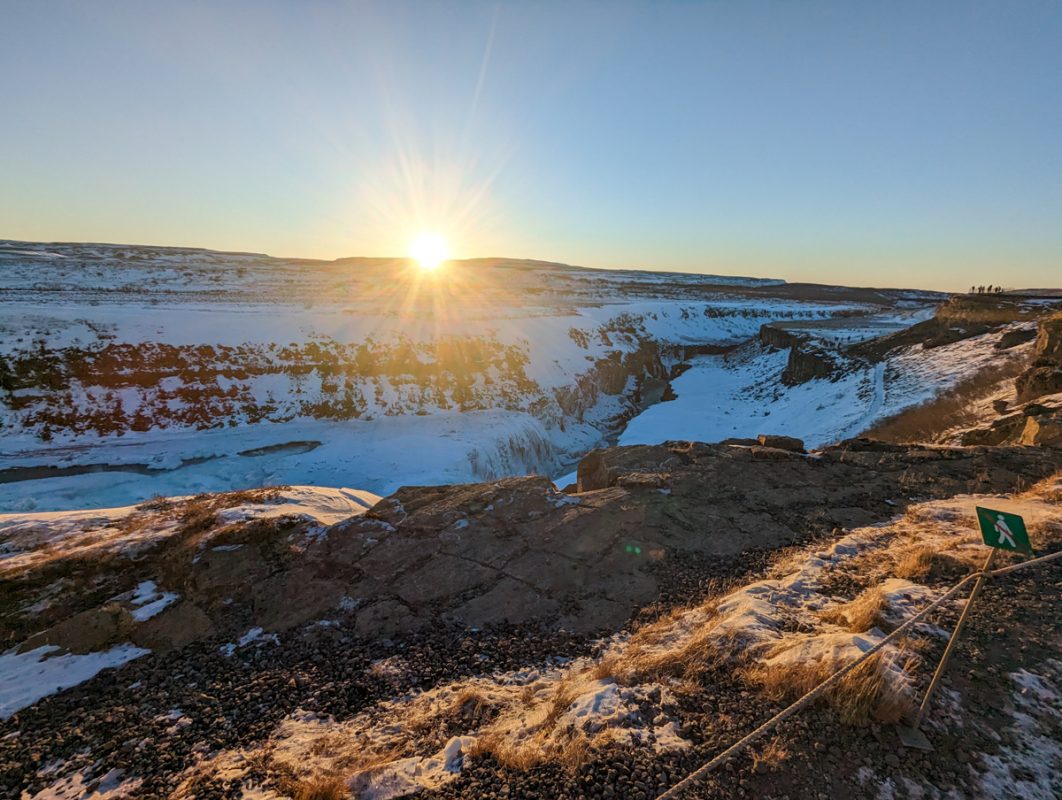When does it snow in Iceland? If you’re planning a trip to the country and wondering, read on for my full guide!
As winter sets in, Iceland transforms.
Hours of daylight reduce dramatically and average temperatures drop.
With the plummeting temperatures comes increasing snowfall.
Iceland’s winter season is long – the first flurries of snow usually make their appearance in October, with winter extending till April.
While snow’s not guaranteed in the coastal areas, you can generally expect to see some when you’re in Iceland in winter.
Whether it’s witnessing the remarkable Northern Lights or embarking on a frosty glacier hike, the winter season in Iceland unveils a fascinating, snow-dusted chapter of this extraordinary island nation.
So, when does it snow in Iceland, where can you find most of the white stuff, and what should you bear in mind if you’re venturing to the snow-covered country?
I learned all about it on my (very snowy) trip to Iceland in January – and we’ll go into it all on this blog post!
When does it snow in Iceland?
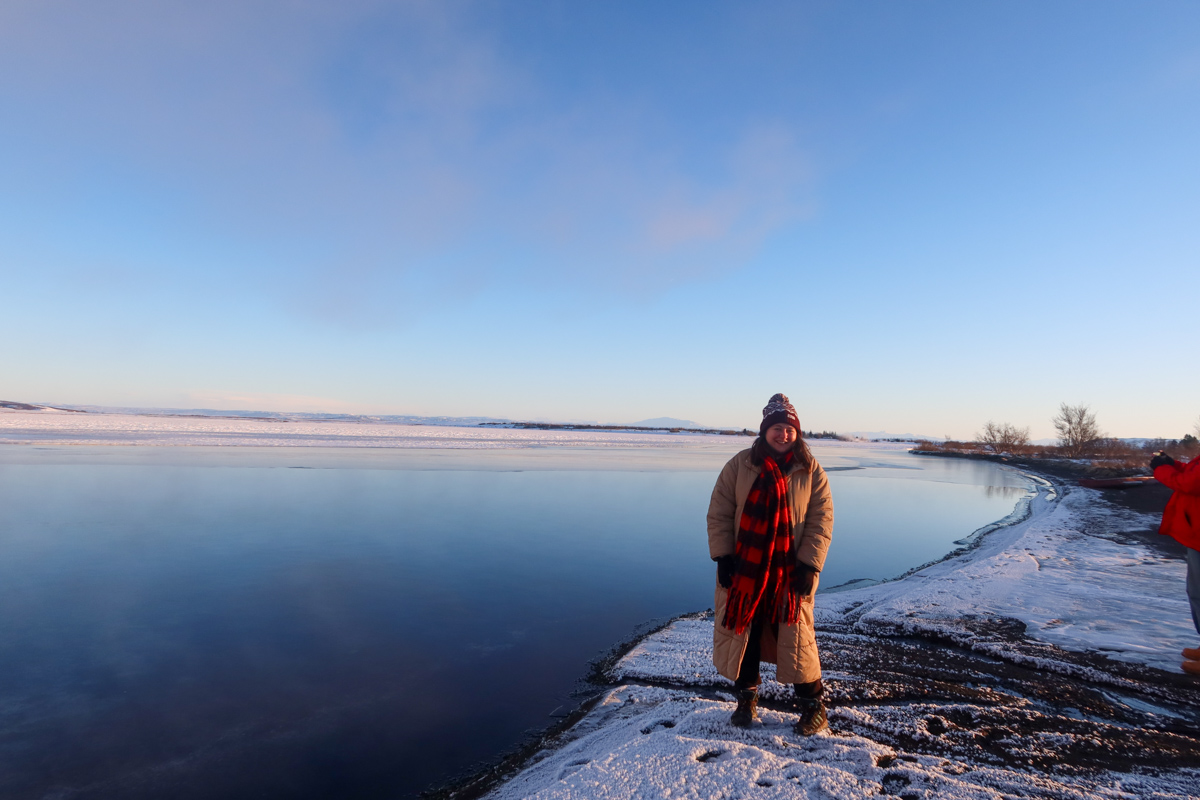
Autumn, fleeting in Iceland, often sees the first snowflakes gracing northern regions and higher grounds.
November sees a higher frequency of snowfall, predominantly in the north.
Peak snowfall occurs in the heart of winter – December, January, and February – blanketing the Icelandic landscapes. Snow is common in all parts of the country in this season.
As March and April roll in, the transition period commences.
Snowfall begins to recede, and winter starts to relinquish its hold.
Snow showers during these months mingle with warmer days and the gradual thaw of the Icelandic landscapes.
Let’s look at a month-by-month breakdown of when it snows in Iceland.
Snow in Iceland in January

As Iceland welcomes the New Year, snow is common across the country – although, along the southern coast, it isn’t guaranteed.
Winter activities are in full swing, and many flock to ski resorts, enjoy ice cave tours or go snowmobiling.
It was extremely snowy (although I didn’t actually experience any snowfall) when I visited Iceland in January; in both Reykjavik and around the Golden Circle.
January’s considered the wettest month in Reykjavik, but I had clear skies for most of the time!
Snow in Iceland in February
The snowfall typically continues throughout February.
The colder temperatures keep the snow around, so there’s typically a thick layer of snow across the country.
It’s still a popular time for tourists to go skiing and enjoy other winter sports.
Snow in Iceland in March
March sees a slight easing of the snow; it may melt in some coastal areas.
As sunset times gradually get later, there’s a perceptible shift in the air as Iceland navigates into the slightly warmer season!
Snow in Iceland in April
By April, the transition from winter to spring is more pronounced.
Snowfall becomes less frequent, and the landscapes slowly start to thaw.
Yet, the highlands and northern regions are often still snow-covered.
Snow in Iceland in May
May sees the final traces of snow disappearing from all but the highest peaks.
The greens of the spring months replace the snow-white vistas of Iceland’s winter.
Snow in Iceland in June, July, and August
Snow during the summer months – June, July, and August – is a rarity in most parts of Iceland.
These months bask in the long daylight hours of the Midnight Sun, and the landscapes burst into life with blooming wildflowers and bustling birdlife.
You can still find ice on the glaciers (8% of Iceland is covered by Vatnajokull, the largest glacier in Europe) and the tops of Iceland’s highest mountains have some snow.
Snow in Iceland in September
As September arrives, the first hints of autumn start to appear, and with it, the possibility of snow in the highlands.
Though it’s a rare occurrence, an early snowfall can occur towards the end of the month.
Snow in Iceland in October
In October, the likelihood of snowfall increases, especially in the north and in the mountains.
There’s also a distinct chill in the air!
Snow in Iceland in November

By November, the first consistent snowfalls usually arrive across the country.
Shorter daylight hours also give way to increased chances of witnessing the magical Northern Lights.
Snow in Iceland in December
As the year reaches its end, December brings with it a full-fledged Icelandic winter.
Snowfall reaches its peak during this month, and white Christmases are common.
That being said, a tour guide in Reykjavik told me that their first snowfall of 2022 didn’t take place until Christmas Eve!
Iceland’s climate
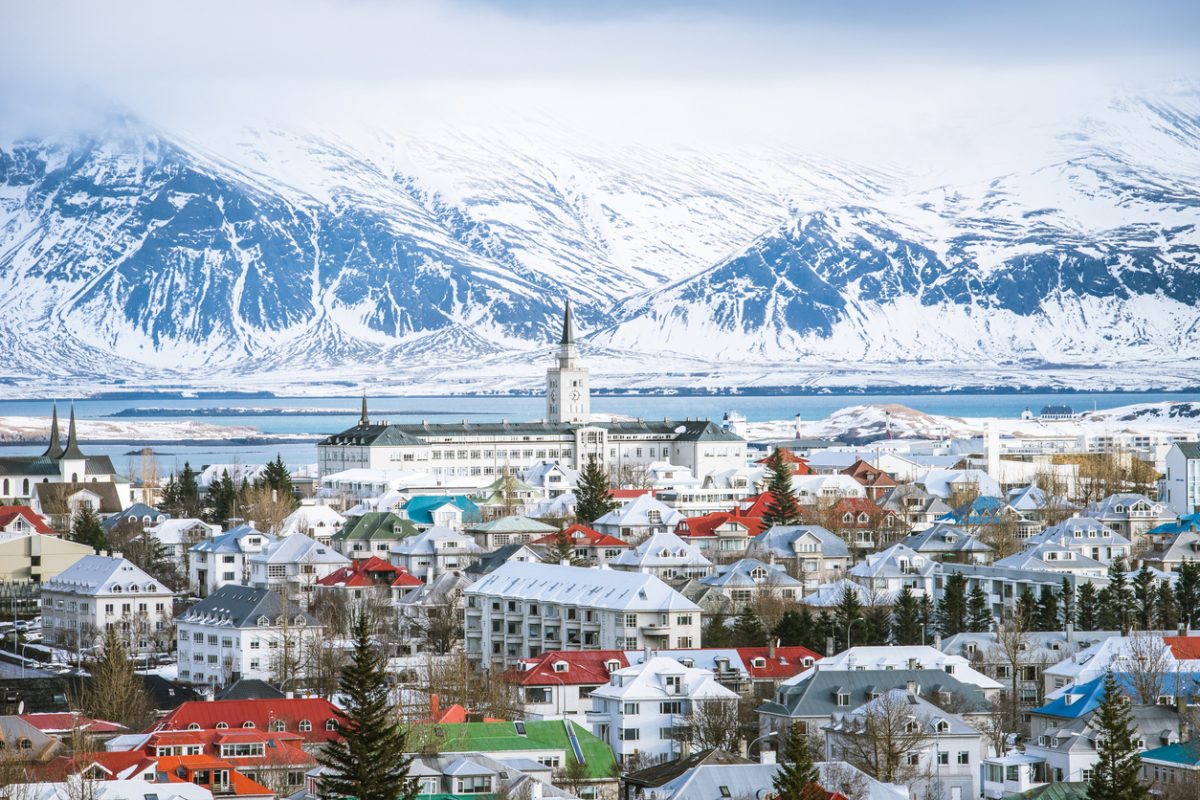
Situated in the North Atlantic, halfway between Europe and North America, the Icelandic climate has been shaped by its northern location and the warm currents of the Gulf Stream.
The Gulf Stream, a powerful, warm ocean current, originates near the Gulf of Mexico and extends all the way up to the North Atlantic.
As it reaches the vicinity of Iceland, it brings with it a warming influence that remarkably moderates the country’s climate, despite its high-latitude position close to the Arctic Circle.
Without the Gulf Stream’s maritime influence, Iceland would have more of a frozen tundra climate, much like Greenland or Siberia.
Reykjavik is the world’s northernmost capital (although it’s not quite in the Arctic Circle – in fact, none of mainland Iceland is).
In Reykjavik, average winter temperatures hover just below freezing, which is a mild climate compared to other locations at similar latitudes.
The Gulf Stream also impacts the snowfall patterns.
The meeting of warm Gulf Stream air and cold Arctic air often results in precipitation, leading to regular snowfall during the winter months, especially in the coastal areas.
Despite the Gulf Stream’s mitigating effect, Iceland’s weather still retains its capricious nature. One local saying goes, “If you don’t like the weather, wait five minutes.”
Bad weather quickly changes in Iceland, and this is an amusing testament to the sudden weather shifts you might experience – a sunny day can swiftly turn into a snow shower, which can turn into heavy rain and vice versa!
It’s best to look at this as another facet of the country’s charm – but be mindful that, whenever you visit Iceland, you can never really predict what the weather will do!
Where Does It Snow in Iceland?
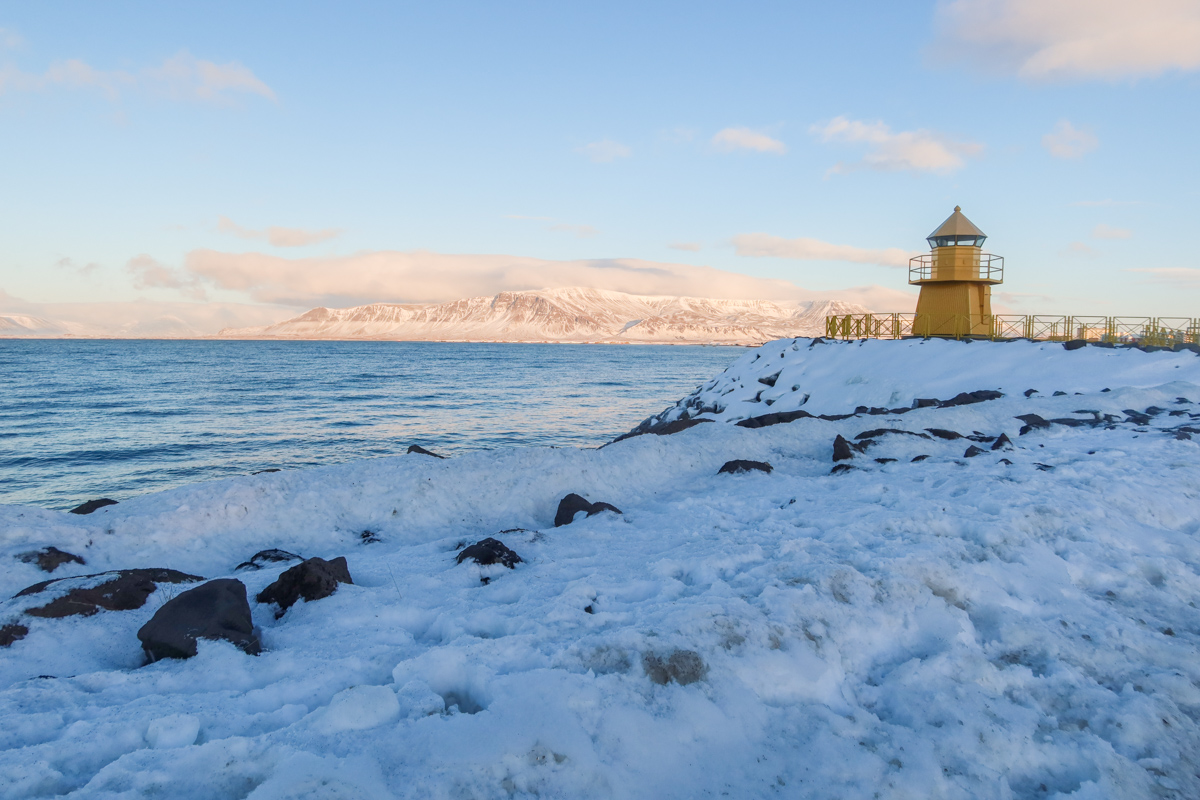
While Iceland isn’t a huge country, it has diverse regions with a range of different climates.
Here’s a deep dive into the different regions of Iceland and how likely snow is in each!
Reykjavik and the Southwest
When does it snow in Reykjavik?
Reykjavik, the world’s northernmost capital, experiences its fair share of snow during the winter months.
The city’s coastal location, moderated by the warm Gulf Stream, generally results in wetter snow, often interspersed with rain.
The snowfall might not be as persistent as in the northern parts of the country, but when I visited Reykjavik in January the streets were completely covered!
This is the same for areas in the southwest, including the Blue Lagoon and Keflavik Airport.
The Golden Circle
The Golden Circle’s home to places like Thingvellir National Park, Gullfoss waterfall, and the Geysir geothermal area – and when I visited, it was covered in snow.
Thingvellir saw temperatures of -19°C (-2.2°F) and Gullfoss was totally frozen.
Generally, it’s much snowier here than in Reykjavik, even though it’s only a 1-2 hour drive away.
The South Coast
South Iceland, known for its beautiful waterfalls and black sand beaches, sees a lesser amount of snowfall compared to the country’s northern regions.
However, when snow does fall, it creates a fascinating contrast, especially against the black volcanic sand of Reynisfjara Beach!
The South Coast is a popular day trip destination from Reykjavik, even in the winter.
The Northern Regions
North Iceland, home to towns like Akureyri and Husavik, receives a considerable amount of snowfall.
The snow here tends to be drier and more powdery, making it ideal for winter activities such as skiing or snowboarding.
The Highlands and Interior
The highlands and interior of Iceland are typically the coldest and snowiest areas of the country.
These regions are often inaccessible during winter due to heavy snow and harsh conditions.
When accessible during the summer months, it’s not uncommon to find patches of snow on higher ground.
The Westfjords
The Westfjords, a remote area in the northwest of Iceland, are known for heavy snowfall and chilly temperatures.
The region’s towering cliffs and scenic fjords draped in snow are an awe-inspiring winter spectacle – but it can be difficult to access them in the winter!
Climate change in Iceland

Climate change is a global concern, but it’s particularly apparent in Iceland.
Global warming, which is associated with climate change, can bring unpredictable shifts in weather and, over time, potential alterations to Iceland’s beloved snowy winters.
Rising global temperatures could lead to shorter and milder winters in Iceland.
Such a shift would directly affect the duration and intensity of snowfall in the country.
Snow might start appearing later in the year and melt away earlier, and snowfall could be less consistent or even scarce during traditionally snowy months.
These changes are not just hypothetical scenarios.
The Icelandic Meteorological Office has noted a general warming trend over the past few decades, with warmer temperatures, especially in the winter months, and changing precipitation patterns.
While it was very snowy when I was in Reykjavik in winter, I have friends who visited in March and didn’t see any snow.
One of the most visual indicators of these changes is Iceland’s glaciers.
These massive ice formations rely on winter snowfall to replenish the ice lost during the summer melt.
However, rising temperatures and changes in snowfall are causing an imbalance, resulting in their steady retreat.
While these potential changes might seem distant, they carry significant implications.
Not only could they alter the look and feel of Iceland’s winters, but they could also impact winter tourism, a vital part of the country’s economy.
Changes in snowfall and temperatures could also affect local ecosystems and wildlife, which are adapted to Iceland’s traditional climate patterns.
Recognizing these issues allows us to better appreciate the delicate balance of nature and the pressing need for global action.
Snow and Daily Life in Iceland

Snow in Icelandic winters significantly shapes its daily routines, transportation, and even its culture.
Locals are well accustomed to the rhythm of the seasons and modify their daily routines accordingly.
For instance, during heavy snowfall, it’s not uncommon to see locals shovelling snow from their driveways early in the morning.
Transport, as expected, is also impacted by snow.
Icelanders are adept at navigating snowy roads, with vehicles suitably equipped for winter driving.
Studded winter tyres are a common sight, and many opt for 4x4s for additional safety and control.
Roads are regularly ploughed and maintained by the road authorities to ensure safety, but in some areas, especially in the highlands, closures are inevitable during peak winter.
An interesting example of snow’s influence on transportation is the tradition of “skíðagangur,” or going on skis.
In more rural or remote parts of the country, there are tales of children skiing to school and farmers checking on their livestock on skis!
Snow also permeates cultural life in Iceland.
A whole array of winter sports and activities come to life with the arrival of snow.
From cross-country skiing and ice fishing to snowmobile tours and ice caving, the snow season has distinctly different activities to the summer!
Travel tips for Iceland in the snow
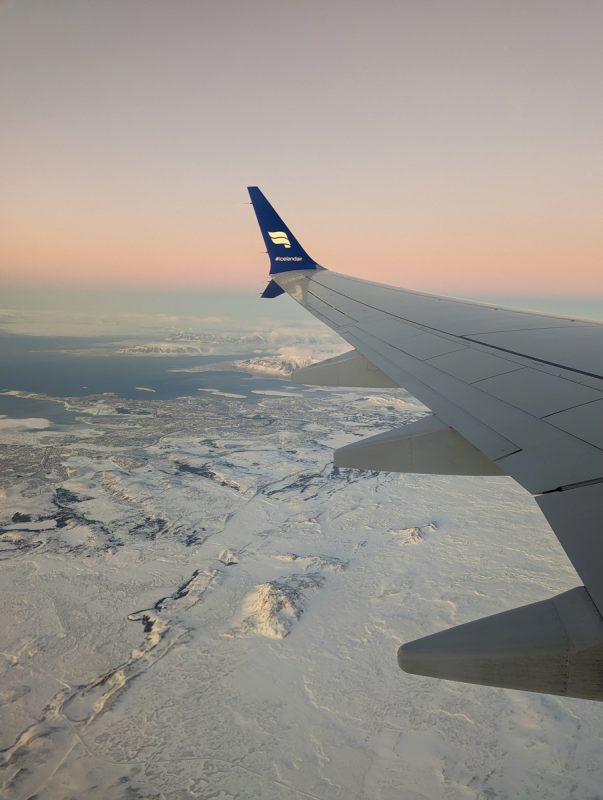
Planning to explore Iceland during its snowy months?
Here are some essential tips and recommendations to ensure a safe, enjoyable, and memorable winter journey.
Safety first
Safety is paramount when travelling in snowy conditions.
Make sure to check the weather forecast and road conditions regularly, as they can change rapidly.
The Icelandic Meteorological Office and the Icelandic Road and Coastal Administration provide up-to-date information on their websites.
Renting a vehicle?
Opt for a 4×4 equipped with winter tires to navigate snowy roads more safely.
And if you’re unfamiliar with driving in snowy or icy conditions, consider joining a guided tour instead.
Dress Appropriately
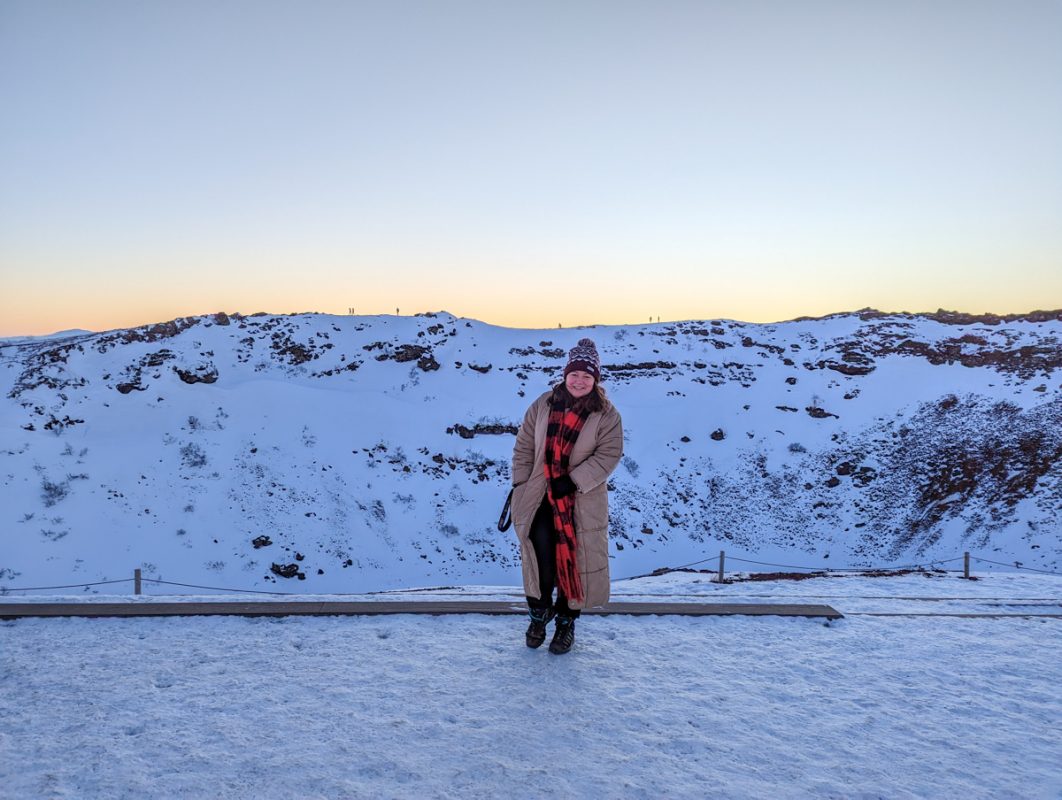
Icelandic weather is notorious for its unpredictability, so dressing in layers is key.
Thermal underwear, waterproof outer layers, sturdy boots, gloves, a hat, and a scarf should be your go-to items.
Don’t forget to pack a swimsuit for a dip in one of the many geothermal pools!
Check out my full Iceland winter packing list by clicking here.
Enjoy the snowy landscapes
Embrace the snow when you’re in Iceland in winter!
Like Norway in the snow, Iceland fully seizes the icy weather.
Popular tours include snowmobiling, skiing, or even ice fishing.
Witness the spectacular sight of waterfalls like Gullfoss and Skógafoss partially frozen, or the black sand beaches of Vik sprinkled with a layer of snow.
Embrace the Aurora Borealis
Winter is the best time to catch the mesmerizing Aurora Borealis or Northern Lights.
Stay outside city lights, keep an eye on the forecast, and prepare for a night spectacle like no other!
I saw them in their full glory in Reykjavik in winter (for me, they were much brighter here than in Tromsø in Norway a month later!).
Try Local Winter Delights
Warm up with Icelandic cuisine!
Try a bowl of traditional Icelandic lamb soup or enjoy a cup of hot coffee paired with kleinur, a type of Icelandic fried pastry.
FAQs about Snow in Iceland

Does It Snow in Iceland?
Yes, it certainly does. Snow is a characteristic part of Iceland’s winter months. Depending on the region and the year, snow can start falling as early as October and last until April or May.
What Month Does It Snow in Iceland?
While it can occasionally snow outside these months, the main snowfall period in Iceland is typically between December and March. During these months, snowfall is more frequent and lasts longer, often leading to substantial accumulations, especially in the northern regions and highlands.
How Many Times Does It Snow in Iceland?
The frequency of snowfall in Iceland varies depending on the region and the year. In general, the northern parts of the country and the highlands experience the most frequent snowfall. It’s difficult to quantify an exact number, but it’s safe to say that during the peak winter months, snowfall can occur multiple times per week.
Does Iceland Have Snow at Christmas?
Yes, Iceland often has snow at Christmas, particularly in the northern regions and the highlands. However, the snowfall can vary from year to year. In some years, even Reykjavik, the capital situated in the southwest, sees a white Christmas, while in others, snow might arrive a bit later in the season.
How cold does it get in Iceland?
In Iceland, temperatures can plummet to subzero levels during the winter, with average lows ranging from -2°C to -10°C (28°F to 14°F). Extreme cold snaps can occasionally push temperatures even lower. The lowest temperature recorded was −39.7 °C (−39.5 °F).
What was the hottest temperature recorded in Iceland?
The highest temperature ever recorded in Iceland was 30.5 °C (86.9 °F) in the Eastern fjords in 1939. However, such extreme temperatures are rare, and warm summer days typically reach 20–25 °C (68–77 °F).
Are you ready for Iceland’s snow?
Whether you’re going on a winter trip to Iceland and want to plan the best snowy activities, or are planning a road trip in the spring and want to know your chances of snow, hopefully, this article has helped!
Iceland has some of the coolest winter weather in Europe, but things are changing fast; so do what you can to protect the natural environment against climate change, both in Iceland and overseas.
If you’re planning an Iceland winter trip, do check out the rest of my posts – I’ve written a tonne based on my last trip to the country (and I’m heading back this winter!).

